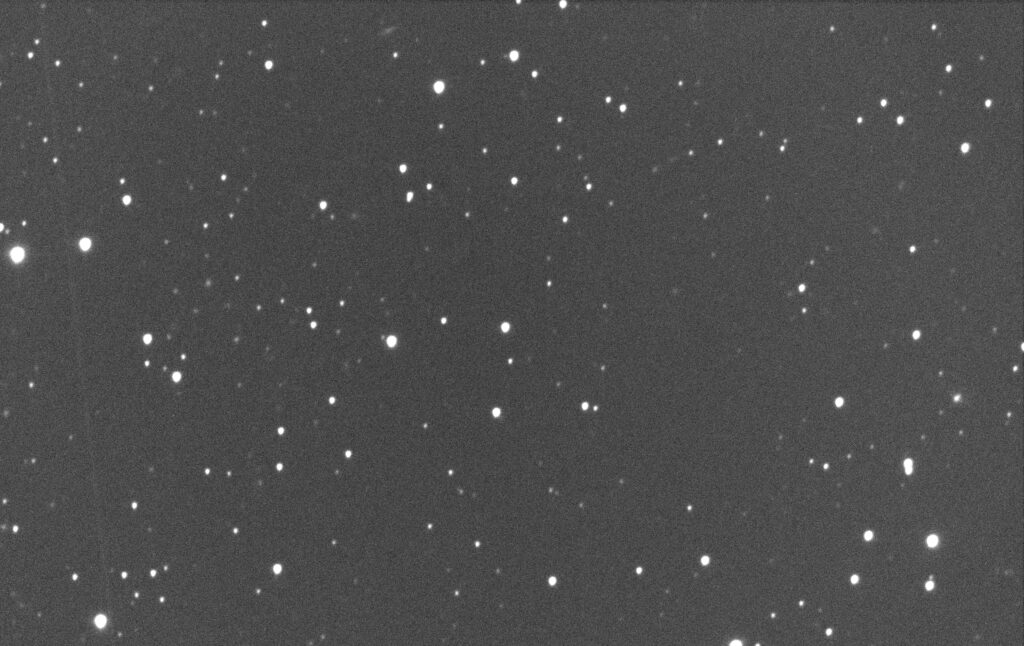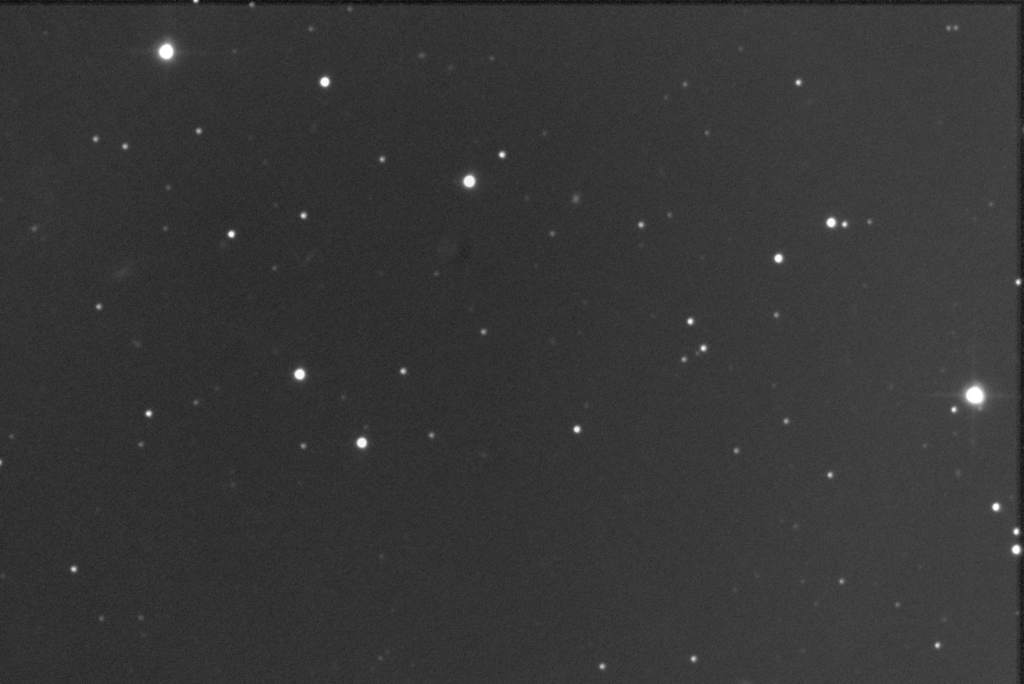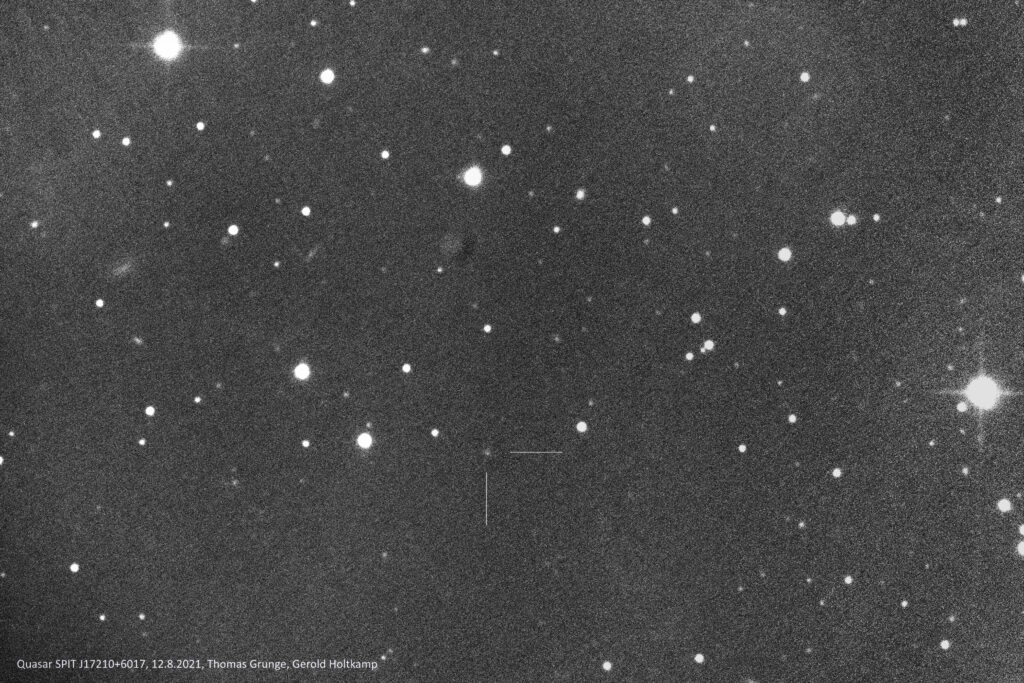Dr. Gerold Holtkamp, 2021.08.23
The observation of two very distant quasars is described. These are very faint objects that can only be imaged with appropriately powerful telescopes. In addition, an extremely light-sensitive camera is required.
Quasars are extreme. They are extremely far away. The travel time of light can be well over 12 billion years. They are also extremely young. What we see is from the beginning of the universe. They are still visible to us because they are extremely bright. They typically have up to 1000 billion times the luminosity of our sun. But they are also extremely small for the amount of energy they emit. The energy-producing area is only the size of our solar system. The image of a quasar is also extremely unspectacular at first glance, namely just a dull point, like a faint star. But if you look at what you actually see on the recording, it gets extremely interesting. It's quite a challenge to your imagination though. Of course, the observing and recording process itself, the "hunt", if you will, is also exciting - at least for oneself.
As an amateur astronomer, you usually don't make your own discoveries. But you can try to be as close as possible to new territory in astronomy. This undoubtedly has its appeal. In order to track down such interesting objects, one can research large catalogues accessible via the Internet in order to find suitable candidates for hunting [1].
I had already imaged a few quasars [2]. The recordings were made with a Canon 6D SLR camera on the large Cassegrain telescope of the observatory of the Natural Science Association Osnabrück. Unfortunately, the Canon 6D is not cooled. It therefore has a high level of thermal noise, especially when the recording chip heats up significantly during recording. This time my new camera, a cooled (!) QHY268M should be used. I hoped to be able to capture much more distant quasars than the previous ones. As a rule, more distant also means fainter. I had filtered out two candidates from the databases that were easy to observe in August:
Quasar QSO J 1723+2243 with a redshift of 4.52 and an apparent magnitude of 18.17 mag in the constellation Hercules
Quasar SPIT J17210+6017 with a redshift of 5.799 and an apparent magnitude of 20.63 in the constellation Draco
On August 11th, 2021 the weather looked promising according to the forecast. The moon would set at 10:33 p.m., astronomical twilight would end at 11:32 p.m. My astro colleague Thomas Grunge and I arranged to meet at the observatory at 10 p.m. And indeed, the weather was as predicted.
The autoguiding, that is the fine adjustment of the telescope, was carried out with the refractor (13 cm aperture, 180 cm focal length), which is piggyback mounted on the main telescope. A Shapley lens was mounted in front of the Starshoot Autoguider guiding camera. PHD Guiding was used as software. The autoguiding went very well right away.
The structure for the actual observation was as follows:
Telescope: Cassegrain with 60 cm aperture and 746 cm focal length
CLS-Filter: IDAS LPS D2
Camera: QHY268M
Recording software: SharpCap 4.0
Image editing: Fitswork, Gimp, Paintnet
First we wanted to try the quasar QSO J 1723+2243. With an apparent magnitude of 18.17, it seemed within reach. 10 lights at 300 s, 5 darks at 300 s and 16 flats at 2 s were recorded.
Camera: Binning=1x1, Read Mode=High Gain Mode, Gain=100, Offset=11, Chip Temperature=-12 °C


Since the quasar with its brightness of only 18.17 mag could already be seen on the unprocessed single image, we were brave enough and dared to use the quasar SPIT J17210+6017.
Camera: binning=2x2, read mode=high gain mode, gain=100, offset=11, chip temperature=-12 °C
Shots: 10 lights at 300 s (8 stacked), 5 darks at 300 s and 16 flats at 2 s
This time, however, almost nothing could be seen on the unprocessed single image, which is no wonder given the low brightness of 20.63 mag. However, after stacking 8 individual images and suitable image processing, the quasar emerged from the darkness! A successful “hunt”!


As you look at it, keep in mind that the dot on the image is not just a dot, but was created by photons created "ages ago" - 12.737 billion years ago - by an unimaginably gigantic source that exceeded the luminosity of our own Milky Way several times over [3]. If that is not an experience ….
______________________________________________________________________________
[1] VERONCAT – Veron Catalog of Quasars & AGN, 13th Edition
[2]
[3]
Die Lichtlaufzeit wurde mit dem sog. „Cosmology Calculator“
http://www.astro.ucla.edu/~wright/CosmoCalc.html aus der Rotverschiebung von 5.799 berechnet. © 1999-2016 Edward L. Wright (2006, PASP, 118, 1711)